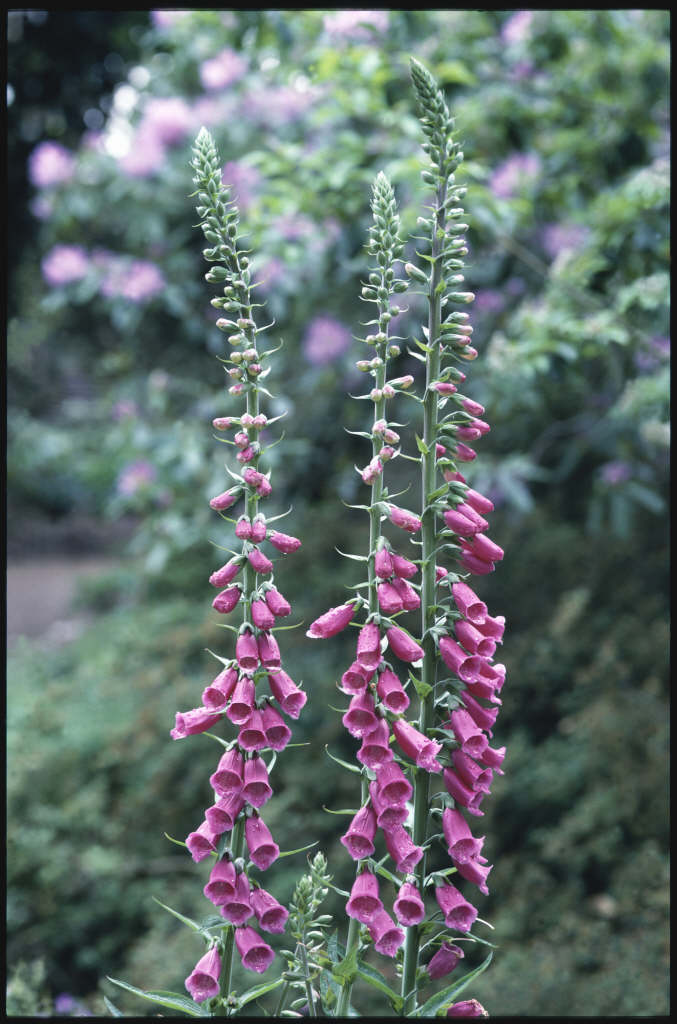Digitalis purpurea
common foxglove
A biennial or short-lived perennial between 1-2m in height, freely self-sowing, with a rosette of softly hairy, oval leaves and tall, one-sided spires of pendant, tubular, bright rosy-purple flowers 6cm long, spotted within, in summer
Other common names
bloody bellsbloody finger
see morecow flop
dead man's bells
dead men's bells
dog's lugs
dragon's mouth
fairy bells
fairy fingers
fairy gloves
fairy thimbles
fairy's cap
fairy's petticoat
fairy's thimble
finger flower
flap dock
folk's gloves
fox finger
gloves of Mary
lady's fingers
lady's gloves
lady's thimble
lion's mouth
lusmore
lustmore
pop dock
thimble finger
thimble flower
throat root
witches' bells
witches' fingers
witches' gloves
witches' thimbles
bysedd y cŵn
Size
Ultimate height
1.5–2.5 metresTime to ultimate height
1–2 yearsUltimate spread
0.1–0.5 metresGrowing conditions
Moisture
Moist but well–drained, Well–drainedpH
Acid, Alkaline, NeutralColour & scent
| Stem | Flower | Foliage | Fruit | |
| Spring | Green | |||
|---|---|---|---|---|
| Summer | Purple | Green | ||
| Autumn | Green | |||
| Winter |
Position
- Full sun
- Partial shade
Aspect
South–facing or East–facing or West–facing
Exposure
Exposed or Sheltered Hardiness
H7Botanical details
- Family
- Plantaginaceae
- Native to GB / Ireland
- Yes
- Foliage
- Deciduous
- Habit
- Bushy
- Potentially harmful
- TOXIC if eaten. Wear gloves and other protective equipment when handling TOXIC to pets - see the HTA guide to potentially harmful plants for further information and useful contact numbers
- Genus
Digitalis can be biennials or usually short-lived perennials forming a rosette of simple leaves with bell-shaped flowers in slender, erect, usually one-sided racemes
- Name status
Correct
- Plant range
- W Europe
How to grow
Cultivation
Grow in almost any soil,but avoid very wet or very dry situations. Prefers a humus-rich soil in partial shade but will grow in full sun. See foxglove cultivation for further advice
Propagation
Propagate by seed sown in-situ in late spring. Alternatively sow in seed trays in late spring and plant out to final position in late summer; deadhead flowers regularly if seed is not required
Suggested planting locations and garden types
- Coastal
- Wildflower meadow
- City and courtyard gardens
- Cottage and informal garden
- Wildlife gardens
- Flower borders and beds
Pruning
Cut back after flowering
Pests
May be susceptible to aphids and leaf and bud eelworm
Diseases
May be susceptible to powdery mildews, downy mildews and leaf spot
Get involved
The Royal Horticultural Society is the UK’s leading gardening charity. We aim to enrich everyone’s life through plants, and make the UK a greener and more beautiful place.
